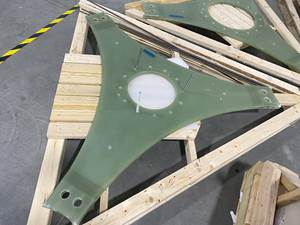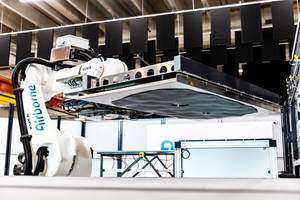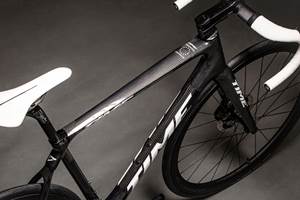CFRP bests steel in precision ball joints
Near-zero backlash in bearings and automation components.
As noted in CW’s feature article on reconfigurable tooling, modular fixture design firm/component supplier Prodtex (Gothenburg, Sweden and Bristol, UK) is not only changing the way that large composite structures are assembled, but also is using composites to build the fixtures themselves. In fixtures that must be lifted and installed by humans and/or manipulated by robots, reduced mass and high stiffness translate into less manpower/smaller robots, increased production speed and, as a result, reduced cost. Toward these goals, Prodtex is now working toward its first all-composite Hexapod positioning robot, using carbon fiber-reinforced plastic (CFRP)-based ball joints produced by Corebon AB (Malmö, Sweden).
“The original idea was to redesign metal ball joints so that they would have less backlash,” recalls Corebon CEO Tobias Björnhov. He explains that the company’s ball joints and bearings, which feature CFRP housings, have near-zero backlash, meaning there is no gap or play between the parts, “so the joint is stiff before you put load on it.” Ordinarily, “if you change direction of the force in a bearing, it could move,” he points out, but claims, “Our structures do not move, because they are preloaded and very stiff.”
Corebon began by reinforcing metal ball-joint housings with CFRP, which were also preloaded by shrink-press fitting the CFRP housing onto the metal ball (aided by the difference in coefficient of thermal expansion). “These were good,” says Björnhov, “but expensive to make.” So Corebon developed an all-CFRP ball joint housing, replacing multiple precision-machined metal parts that must be perfectly assembled around the ball with a single CFRP molding. Molding and preloading the two-part assembly (the ball remains metal) is achieved in a single step, using proprietary technology.
Corebon also makes sliding bearings and other kinematic pairs — i.e., two connected objects that impose constraints on their relative movement, such as a piston in a cylinder, ball joints and bearings — as well as parts for robots, like the CFRP domes pictured at top right. Björnhov explains that this dome comprises the robotic wrist of the end-effector, “where you would attach a motor/spindle for a machining tool or tape-laying head, etc.” He notes that future iterations of these domes might also be used as nodes in the large yet lightweight “spider” fixtures for assembly, such as those made by TETRAFIX AB (Kungälv, Sweden) and Prodtex’ Lightweight Structures. “Our first applications have been in robots where high precision is required. By reducing the weight of the end-effectors we increase precision and speed.” How much weight reduction? “From 27 kg down to 5.5 kg for the robotic wrist/tool holder structure,” says Björnhov.
Although the CFRP dome is cored with ROHACELL polymethacrylimide structural foam from Evonik Corporation (Darmstadt, Germany), Corebon also gains high specific strength and stiffness by maximizing fiber content. “We achieve a very high fiber volume — up to 80% — which is close to the theoretical maximum possible,” notes Björnhov. This is not only startling, but it also has intriguing implications. “The fibers actually touch,” he explains, “so we get high thermal and electrical conductivity, not only in-plane but in the z-direction as well.”
The manufacturing process that enables this, now covered by an array of patents, was derived from efforts to improve resin transfer molding (RTM) and control of resin injection and heating. “We inject the resin, not only for RTM processing but also for compression molding and filament winding,” Björnhov points out. “The key is that we heat from the inside of the composite, so we control the heat volumetrically, he notes, adding, “This is not bound to any specific type of matrix.”
The key here is inductive heating technology. But Björnhov explains that Corebon’s differs from other inductive heating-based composites manufacturing, “both in the inductors we use and how we control the electromagnetic field.” The resulting instant and uniform 3D heating may be applied to almost any CFRP process, including prepreg cure and pultrusion. It reportedly offers cycle times 10 times faster than conventional composites processes, reduces energy costs by as much as 95% and uses molds that are 20 times lighter than steel. Corebon is licensing the technology, and already has partnerships with Japanese companies, including Sumitomo Corp. (Tokyo, Japan).
“Now we are looking at other applications, such as automotive suspensions and aircraft components that need kinematic pairs with high accuracy and stiffness,” says Björnhov. Corebon also is preparing for the industrial scale required in these industries, with several projects in progress to demonstrate its ability to produce at high volume
Related Content
RTM, dry braided fabric enable faster, cost-effective manufacture for hydrokinetic turbine components
Switching from prepreg to RTM led to significant time and cost savings for the manufacture of fiberglass struts and complex carbon fiber composite foils that power ORPC’s RivGen systems.
Read MoreModular, robotic cells enable high-rate RTM using any material format
Airborne’s automated ply placement systems at Airbus, GKN Aerospace and Teijin Automotive Technologies aim to maximize flexibility and intelligent automation.
Read MorePlant tour: Albany Engineered Composites, Rochester, N.H., U.S.
Efficient, high-quality, well-controlled composites manufacturing at volume is the mantra for this 3D weaving specialist.
Read MoreTime Bicycles to modernize composite bicycle manufacturing
With the aid of KraussMaffei, Clemson University and SC Fraunhofer USA Alliance, Time anticipates a transition to HP-RTM for more efficient carbon fiber bike frame manufacture, plus a new facility in South Carolina.
Read MoreRead Next
VIDEO: High-volume processing for fiberglass components
Cannon Ergos, a company specializing in high-ton presses and equipment for composites fabrication and plastics processing, displayed automotive and industrial components at CAMX 2024.
Read MoreDeveloping bonded composite repair for ships, offshore units
Bureau Veritas and industry partners issue guidelines and pave the way for certification via StrengthBond Offshore project.
Read More“Structured air” TPS safeguards composite structures
Powered by an 85% air/15% pure polyimide aerogel, Blueshift’s novel material system protects structures during transient thermal events from -200°C to beyond 2400°C for rockets, battery boxes and more.
Read More






















